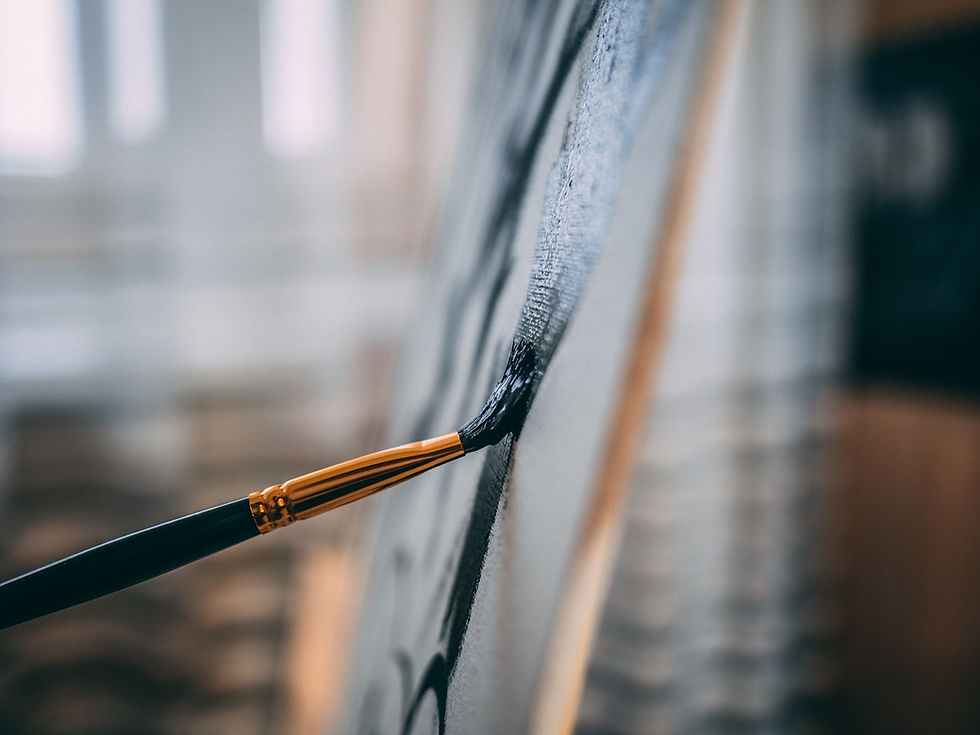4 Most Common Artist Paints
- Jaici Shiemke

- Mar 23, 2022
- 3 min read
Updated: Mar 28, 2023

The 4 most common types of paint used by artists today are oil, acrylic, gouache, and watercolor. In this order, oil is the stiffest and watercolor is the most fluid; this stiffness also corresponds with how stiff the brush needs to be to work with the paint.
Nearly all paints (regardless of category) are simply made of pigments and a binder. The binder is what determines how it will act and the qualities it will have to make it a certain type of paint.
Note: It's uncommon, but some paints use mica powder or dye to color the paint instead of pigment. It's good to look further into these as they may not be lightfast.

Oil Paint
This is the most traditional paint to use when working in high detail. They may seem similar to acrylics, but are much easier to blend (due to longer drying times) and will dry in a glossy finish. They aren't normally the choice for kids, as they require harsh chemicals to clean paint off brushes.
Oil paints can be used on canvas or wood that has been treated with gesso. (Gesso creates a barrier and gives the paint something to bind onto.)

Acrylic Paint
It's one of the most common choices for young artists because it has many uses and can be mixed with a variety of mediums to create different thicknesses, textures, and effects. Acrylic paint also comes in a few varieties, mainly differing in viscosity (how thick or fluid it is). These include heavy body, open body, fluid, and high flow. See this video for more.
Acrylic paint generally dries somewhat glossy, but not quite as much as oils. I believe there are mediums you can add to paint to make them more matte or glossy.
These can be used on canvas and wood (that has been treated with gesso) and paper.
Acrylic paint can be watered down to act similar to watercolor, though this technique isn't recommended when used on gessoed canvas or wood because it may start cracking later.

Gouache Paint
This paint is very unique in that it can hold qualities of both acrylic and watercolor paints. As is, it can be used like acrylic, but if you add water to it, you can use it like watercolors. Because it is water-soluble, it's easy to clean and can reactivate when rehydrated. Gouache is also known to dry with a matte finish, and crack if bent or folded.
Acryla Gouache is a subcategory of gouache that can be used as it normally would, but when it dries, it won't reactivate with water. Some artists like this because it won't mess up layers that have already dried, but otherwise keeps the same attributes.
Because gouache acts a little more like watercolors, it should be used on paper.

Watercolor Paint
Another popular choice, especially among beginner artists, watercolors are easy to setup and cleanup. They come in a variety of forms including pans, tubes, concentrated liquid, pencils, and markers. Pans and tubes are the most commonly used, but it's really about preference.
Watercolors are traditionally used on paper or watercolor blocks (glued stacks of paper). No treatment is needed for this type of application because watercolor paper is already treated. However, you can use watercolor paint on canvases that have been treated with watercolor ground or absorbent ground.
Because watercolors are transparent, it's best to put down light paint layers first, then add darker and darker ones.
Fun Fact
Did you know in the 1700's to 1800's the rich brown paint "mummy brown" swept across Europe? It was very popular among oil painters until they found out it was made from real Egyptian mummies.
Student VS Professional Paint
The general differences between student and professional paint (of any type) is it's saturation (how brilliant the color appears), lightfastness (how long the color will last without fading), workability (how it acts when used), and cost.
Cheaper paints use less or cheaper pigments and fillers to reduce costs. There's nothing wrong with using them to get an idea of what painting is like; especially when each type of paint works differently. It is good practice however to switch to professional grade paints when selling artwork so it won't fade over time.
*See my other article for more details: Differences between Beginner, Amateur, and Professional Grade Paints.


Comments